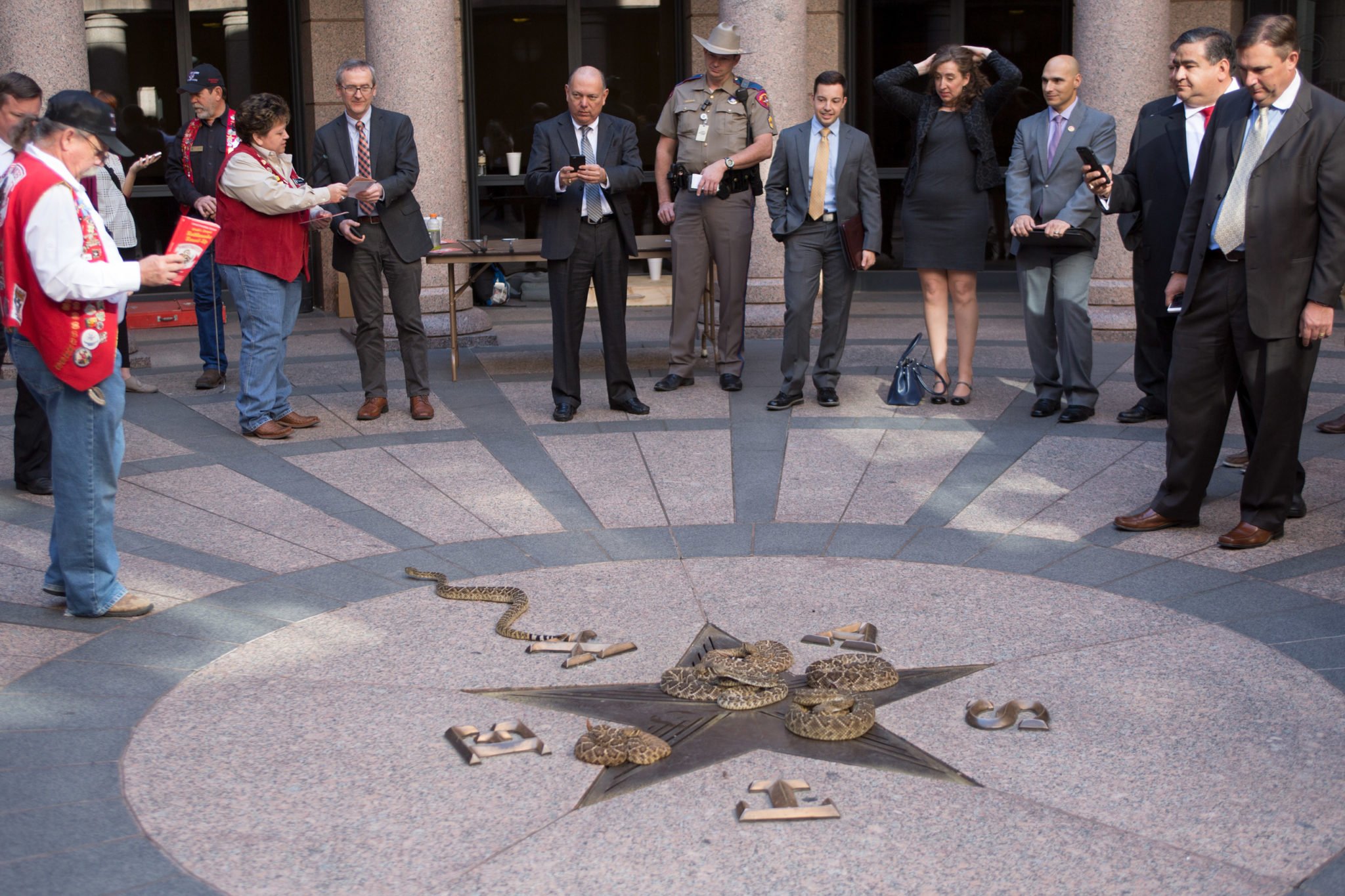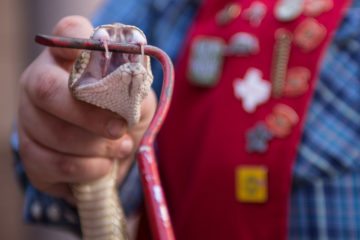
‘Diamondback Day’ at the Texas Capitol Belies a Serpentine Controversy
It’s all in good fun when rattlesnakes descend on the Capitol each February, but the way they’re hunted is no laughing matter.


Visitors to the Texas Capitol this week could be forgiven for doing a double take while passing by the open-air rotunda. Eight Western diamondback rattlesnakes slithered and coiled over the bronze star of Texas on the pink granite floor, their collective hissing a constant background hum. A dozen teenagers in 4-H Day T-shirts approached the snakes, then darted away with nervous laughter, while a gaggle of legislative staffers hung back, sipping from Starbucks cups and scrolling on their phones. “There’s a lot more snakes inside the Capitol than there are out here,” said one man, who wouldn’t give his name.
Diamondback Day, as it’s called, is among the most Texan of statehouse traditions. Every February since 1981, the rattlesnake wranglers of the Sweetwater Jaycees have made the four-hour drive to Austin with a van full of snakes. It’s billed as an educational and safety demonstration, but the real goal of the three-day display is to promote the Sweetwater Rattlesnake Roundup, which brings more than 25,000 visitors and $8 million to Nolan County each March. The 59-year-old festival features a Miss Snake Charmer pageant, a chili cook-off and guided snake hunts, and it raises money for local nonprofits and Little League teams. It’s also been criticized by scientists and animal rights advocates for the controversial main event, in which thousands of rattlesnakes — a record 24,000 pounds last year — are piled into a pit, milked for their venom, stunned, skinned alive and eaten.
The Jaycees say the roundup makes their community safer by cutting down on the local rattlesnake population. “We’re overrun with ’em,” said member David Sager. “When we started coming [to the Capitol] in 1981, we had one or two people every month bitten by a rattlesnake. The people who are against catching rattlesnakes, they don’t live with them.”

Snakebites are exceedingly rare, however. According to the Texas Department of State Health Services, about 7,000 Americans, or 1 in 37,500, are bitten by venomous snakes each year. Half of those are “dry” bites without venom, and only 0.2 percent are fatal. One or two Texans will die from a snakebite annually.
There’s another aspect to the controversy. The method that many rattlesnake hunters in Sweetwater use to catch their prey, called gassing, has been banned in 29 states. Gassing involves pumping gasoline into snake dens until the critters can’t breathe, forcing them out en masse. Sometimes likened to fishing with dynamite, it’s the quickest way to procure the biblical quantities of snakes that roundup organizers say make their event the world’s biggest.
In 2014, the Texas Parks and Wildlife Department (TPWD) commissioned a Snake Harvest Working Group to look into whether gassing should still be legal in Texas. The 11-member group included both biologists and roundup promoters, and their recommendations were split along predictable lines. In its final report, released in January 2016, the group essentially threw up its hands. “It became clear through the process that perspectives within the [working group] related to the various aspects of the gassing issue were not unanimous and that it would not be possible to provide what was assigned to the group,” wrote TPWD wildlife diversity program director John Davis.
Jaycees member Blake Stephens said that because he and other Texas hunters use gasoline fumes, rather than liquid, their method isn’t cruel. “The gassing that we do here versus what they’ve done in Oklahoma, Georgia, places like that, it’s different,” Stephens said. “We use the fumes, and it’s a small amount. It’s in an insecticide can and we put maybe a quarter of a gallon in. … It just makes the snakes come up for fresh air.”
Rob Denkhaus, a scientist who served on the working group and manages the Fort Worth Nature Center and Refuge, called that distinction arbitrary. “It’s very obvious that putting gasoline in any quantity in the ground has negative impacts,” Denkhaus said. “As a biologist, I cannot fathom how anybody couldn’t see the potential damage to be done here.”

Beyond cruelty to the snakes, Denkhaus said, a bigger threat is the environmental risk that gas poses to the water table and to other species. Rattlesnakes thrive in Texas’ karst environments, geological regions marked by underground caves and soluble bedrock. These zones are home to many of the more than 1,300 species given the state’s “greatest conservation need” designation, plus others that scientists haven’t yet discovered. “We’re potentially wiping out species we never had the opportunity to know existed,” Denkhaus said.
In a statement last month, TPWD said that its wildlife experts “still believe that there are better options for collecting snakes that do not adversely impact non-target species, and we will continue to work to develop and implement best practices that reduce potential impacts to these species.” But, the agency said, “at this point there is not enough support from either the community or legislative oversight for the department to move forward.” That means for the foreseeable future, the Jaycees will continue to hunt with gasoline and the snakes will stay in the Capitol.


